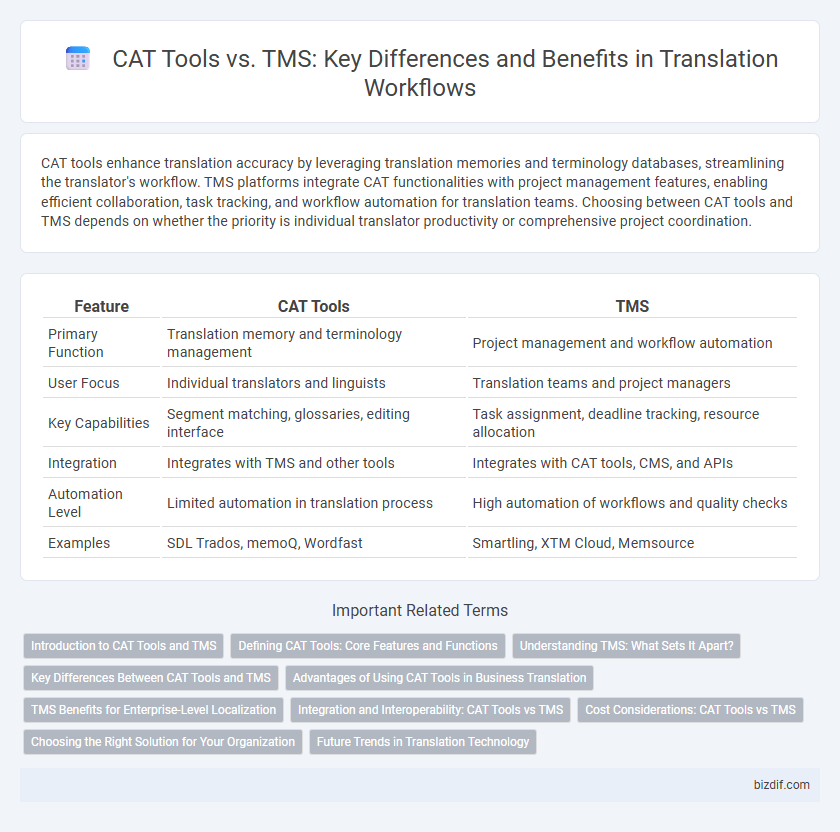CAT tools enhance translation accuracy by leveraging translation memories and terminology databases, streamlining the translator's workflow. TMS platforms integrate CAT functionalities with project management features, enabling efficient collaboration, task tracking, and workflow automation for translation teams. Choosing between CAT tools and TMS depends on whether the priority is individual translator productivity or comprehensive project coordination.
Table of Comparison
| Feature | CAT Tools | TMS |
|---|---|---|
| Primary Function | Translation memory and terminology management | Project management and workflow automation |
| User Focus | Individual translators and linguists | Translation teams and project managers |
| Key Capabilities | Segment matching, glossaries, editing interface | Task assignment, deadline tracking, resource allocation |
| Integration | Integrates with TMS and other tools | Integrates with CAT tools, CMS, and APIs |
| Automation Level | Limited automation in translation process | High automation of workflows and quality checks |
| Examples | SDL Trados, memoQ, Wordfast | Smartling, XTM Cloud, Memsource |
Introduction to CAT Tools and TMS
CAT tools, or Computer-Assisted Translation tools, enhance translators' productivity by providing features such as translation memory, terminology management, and real-time collaboration. Translation Management Systems (TMS) offer comprehensive platforms that streamline the entire localization process, including project management, workflow automation, and vendor coordination. Both CAT tools and TMS play crucial roles in modern translation workflows, with CAT tools focusing on translation accuracy and efficiency, while TMS optimize project oversight and delivery timelines.
Defining CAT Tools: Core Features and Functions
CAT tools, or Computer-Assisted Translation tools, streamline the translation process by offering features such as translation memory, terminology management, and real-time suggestions to ensure consistency and accuracy. These tools enhance productivity by reusing previously translated segments and managing linguistic assets efficiently across projects. Essential CAT tool functions also include quality assurance checks, collaboration capabilities, and integration with popular file formats to support diverse translation workflows.
Understanding TMS: What Sets It Apart?
Translation Management Systems (TMS) streamline the entire localization workflow by integrating project management, resource allocation, and collaboration tools, unlike CAT tools that primarily focus on translation memory and terminology management. TMS platforms offer centralized dashboards for real-time tracking, automated workflow routing, and seamless integration with content management systems, enhancing efficiency in large-scale multilingual projects. This holistic approach to translation project oversight distinguishes TMS as an essential solution for organizations managing complex, ongoing translation needs.
Key Differences Between CAT Tools and TMS
CAT tools focus on enabling translators to work efficiently by providing features like translation memory, terminology management, and real-time editing. TMS platforms offer comprehensive project management capabilities, including workflow automation, collaboration, and resource allocation to streamline the entire translation process. The key difference lies in CAT tools targeting individual translation productivity, while TMS emphasizes managing and optimizing large-scale translation projects across teams.
Advantages of Using CAT Tools in Business Translation
CAT tools enhance business translation efficiency by leveraging translation memory databases to maintain consistency across projects and reduce repetitive work. These tools enable translators to access terminology management and segment alignment, improving accuracy and adherence to brand-specific language. Integration with various file formats and real-time collaboration features further accelerate project turnaround and support scalable translation workflows.
TMS Benefits for Enterprise-Level Localization
Translation Management Systems (TMS) offer enterprise-level localization with enhanced scalability, centralized workflow automation, and real-time collaboration across global teams. Unlike CAT tools that focus on individual translators, TMS integrates seamlessly with content management systems, ensuring consistent terminology and faster project turnaround. Advanced reporting and quality assurance features in TMS improve localization accuracy and ROI for multinational organizations.
Integration and Interoperability: CAT Tools vs TMS
CAT tools offer robust integration with translation memories and glossaries, enhancing linguistic consistency and workflow efficiency for individual translators. TMS platforms provide extensive interoperability by connecting with various CAT tools, content management systems, and machine translation engines, streamlining project management for large teams. The seamless exchange of data between CAT tools and TMS accelerates translation cycles while maintaining quality across multilingual projects.
Cost Considerations: CAT Tools vs TMS
CAT tools generally require a one-time license fee or subscription, making them more cost-effective for freelancers and small agencies. TMS platforms often involve higher upfront investments and ongoing maintenance fees, suited for large enterprises managing complex translation workflows. Evaluating total cost of ownership, including integration and scalability expenses, is crucial when choosing between CAT tools and TMS solutions.
Choosing the Right Solution for Your Organization
Selecting the right language technology involves comparing CAT tools and TMS based on project scope, collaboration needs, and workflow integration. CAT tools excel in enhancing translator productivity with features like translation memory and terminology management, ideal for individual linguists or small teams. TMS platforms offer comprehensive solutions for managing large-scale translation projects, providing automation, version control, and seamless coordination across multiple stakeholders.
Future Trends in Translation Technology
CAT tools will increasingly integrate with cloud-based TMS platforms, enabling seamless collaboration and centralized project management. Artificial intelligence and machine learning will enhance translation quality and automation, optimizing workflows across both CAT tools and TMS. Future translation technology trends emphasize interoperability, real-time processing, and scalability to meet growing global content demands.
CAT Tools vs TMS Infographic

 bizdif.com
bizdif.com